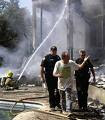 Carbon monoxide
Carbon monoxide according to the Journal of the American Medical Association. Yet while 93% of U.S. homes have smoke alarms, the Consumer Product Safety Commission estimates that only 15% have carbon monoxide alarms.
Such alarms are vital because carbon monoxide is virtually invisible to us. It is a flammable, colorless, odorless and tasteless toxic gas.
You can’t see or smell carbon monoxide, but at high levels it can kill a person in minutes.
- Low levels of carbon monoxide poisoning are mistaken for flu or cold symptoms - shortness of breath on mild exertion, mild headaches, nausea.
- Higher levels cause dizziness, mental confusion, severe headaches, nausea, fainting on mild exertion. Very high levels lead to unconsciousness and death.
Avoid dangerous CO levels in your home:
• Install a battery-operated CO detector/alarm in your home and check or replace the battery when you check your smoke alarms and change the time on your clocks each spring and fall. Mount the detector/alarm on the ceiling at each level in your home.
• If you are suffering from continuing, chronic flu-like symptoms, see your doctor and ask her if it could be a low-level CO poisoning.
• If you have a CO detector, and it alarms, immediately open windows and ventilate your home with fresh air, have your heating system checked by a professional.
• Be sure that CO is not escaping from any fuel-burning appliance (furnace, water heater, fireplace, woodstove, or space heater.)
• Do not block or seal shut exhaust flues or ducts for appliances such as water heaters, ranges, and clothes dryers.
• If you live in a newer home, it is probably built to be very air-tight. Thus it cuts down on the supply of fresh air to your furnace, creating an oxygen starved flame. As well, tight closing replacement windows and doors, as well as additional insulation can cause similar “air-tight” problems in older homes.
• Be sure your flues that are connected to new high-efficiency furnaces and water heaters are sized right. If not, they can cause CO spillage.
• Also many new furnaces and water heaters are installed using the existing chimneys that may be the wrong size to allow the furnace to vent properly.
• Carbon monoxide can spill into the home from vent connections in poorly maintained or blocked chimneys. If the flue liner is cracked or deteriorated, CO can seep inside through the liner, slowly creeping up to dangerous levels. If a nest or other materials restrict or block the flue, CO will mostly spill back into the house.
• Never warm up vehicles in a garage attached to your home, even when your garage door is open. Do not operate other gasoline-powered engines in confined areas such your garage or basement.
Do not leave your car, mower, or other vehicle running in an attached garage, even with the door open.
You may be allowing concentrated amounts of CO to enter your home through the garage door or near-by windows.
• Get an EAC (electronic air cleaner) that attaches to your existing HVAC system, one that is sufficiently efficient to eliminate harmful levels of CO in your home.


















































